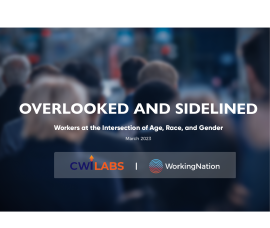Updates & Analysis
Announcement: Coursera Partnership
The Center for Workforce Inclusion (Center), the only national organization dedicated exclusively to the workforce development needs of older workers, proudly announces a collaborative venture with Coursera, one of the largest online learning platforms in the world. This partnership will provide curated course libraries to older job seekers nationwide, addressing the pressing need for critical skills training in an evolving job market.

New Content Added to Our e-Magazine
We’ve added exciting new video clips and articles to our e-magazine, Overlooked and Sidelined: Workers at the Intersection of Age, Race, and Sex. The content comes from our 2023 Summit and includes an interview with Governor Wes Moore of Maryland, a presentation on the challenges faced by older workers from Julia Pollak, Chief Economist at ZipRecruiter, and a panel discussion on The Implications of AI for Older Workers led by Ramona Schindelheim, Editor-in-Chief of WorkingNation.

4 Ways AI Can Help Older Workers Get Hired
Not only are many AI tools easy to access, but they have the potential to create a more inclusive and equitable job market for older workers.

Navigating Workplace Dynamics: Intersections of Age, Race, and Sex for Hispanic/Latino Older Workers – Part 2
In the second installment, we turn our focus to occupational segregation and access to opportunities for Hispanic/Latino older workers. Research shows that they are often concentrated in lower-paying jobs with limited upward mobility. By examining the root causes of occupational segregation, we aim to identify actionable steps towards fostering inclusivity and leveling the playing field in the workplace.

Navigating Workplace Dynamics: Intersections of Age, Race, and Sex for Hispanic/Latino Older Workers – Part 1
The first part of our series examines the labor force participation rates and wage disparities among Hispanic/Latino older workers. Despite high participation rates, data from the U.S. Bureau of Labor Statistics reveals persistent wage gaps compared to non-Hispanic counterparts. We delve into the factors contributing to these disparities and explore strategies for achieving equitable compensation.

